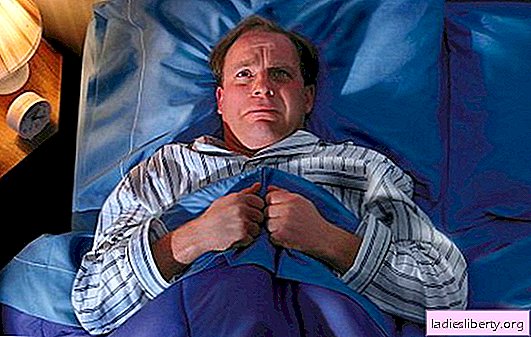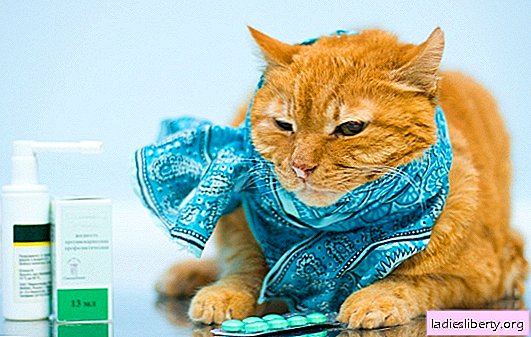
Cramps are cramps in the muscles that most commonly occur in the legs.
Studies show that almost 75% of all people have these conditions.
Night cramps are considered more dangerous and uncomfortable than those observed during the day.
Let us consider in more detail what needs to be done with cramps at night, and what factors can trigger this unpleasant phenomenon.
What to do with cramps at night: the causes of their occurrence
Most often, night cramps develop for such reasons:
1. Excessive physical exertion on the legs, which was transferred during the day (too active training in the gym, weight lifting, walking for long distances, etc.) This could cause overwork of the muscles and the occurrence of cramps.
2. Sedentary work, in which blood circulation in the lower part of the body is disturbed, which provokes convulsions.
3. Previously suffered leg injuries (fracture, sprain, bruise), which make themselves felt in the form of aching pains, burning sensations and periodic cramps.
4. An acute shortage of useful substances in the body (calcium, potassium, magnesium, iron) can also cause this manifestation.
5. Progressive diabetes.
6. Pregnancy, especially in the third trimester, can provoke sudden cramps. This is explained by the fact that in such a period the fetus is already large enough and can squeeze some vessels to lead to numbness of the legs (or one leg) and the occurrence of seizures in it.
7. Cirrhosis of the liver.
8. Progressive atherosclerosis.
9. Varicose veins, especially if it is not treated.
10. Various pathologies in the thyroid gland.
11. The development of seizures due to stress.
12. Violation of blood circulation in a dream, which leads to a lack of necessary trace elements in muscles and their cramps.
13. Acute infectious diseases, especially tetanus, can provoke this condition.
14. Diseases of a neurological nature, as a result of which a person's nerve cells are affected. This leads to the fact that such cells cease to properly perform their functions and provoke the development of night cramps.
15. Convulsions can also develop as a side effect of taking medications. Most often, this condition is provoked by such medications: diuretics, nicotinic acid, raloxifene.
16. Parkinson's disease.
17. The lack of vitamin D.
18. Severe dehydration (may be subject to the wrong diet).
19. Hypoglycemia (a condition in which a person lowers blood sugar).
20. Vascular disease.
Additional factors that can trigger night cramps include:
• excessive consumption of alcoholic beverages;
• the presence of an inflammatory process in the body;
• flat feet;
• severe hypothermia;
• stroke;
• hypertension.
What to do with cramps at night: first aid
When seizures occur for the first time, a person may not even immediately understand what happened, because before he did not experience such pain. In this state, the main thing is to remain calm and follow a set of recommendations.
As a rule, with convulsions, a person feels a burning sensation, pulling or aching pain. There may also be numbness of the limb, a sensation of "running goose bumps" on the skin, as well as a complete loss of sensitivity of certain areas of the legs (foot, calf, fingers). It is important to know that an attack of seizures alone does not cause serious harm to the body's systems, that is, it is not vitally dangerous.
Typically, such attacks last from two to eight minutes, after which the function of the legs is restored.
So, if convulsions occur at night, you must:
1. Sit on the bed and examine the leg.
2. Pinch a tense muscle to relieve spasm.
3. Intensively grind the area that seizure seized to increase blood flow to it. This can be done using alcohol, which will also help warm the limb.
4. Next, you should carefully stand up, do not make sudden movements (with a strong cramp, a person may simply not stand on his feet).
5. Without bending the knees, try to touch the floor with your fingers to stretch the reduced muscles of the legs.
6. If it is difficult for a person to get out of bed, then the same exercise can be done while lying down, the main thing is to make your body "work" and relieve spasm.
7. Next, you need to try to walk around the room a bit, squat and even jump, thus dispersing the blood and returning the sensitivity of the legs.
8. A warming compress is allowed to be applied to the place where the cramp occurred.
9. After doing the exercises, go to bed and lay your legs so that they are above the level of the pelvis. To do this, under the knees and feet, you can put elastic pillows or fabric rollers. This action will ensure normal blood circulation and relieve pain.
10. With severe pain, you can drink a light analgesic (Paracetamol, Ibuprofen, etc.).
It is important to know that if the seizure does not go away for a long time, then this can be a serious signal, because sometimes it can be confused with the development of paralysis, which is a very dangerous condition. As a result of this, if after ten minutes the convulsion does not release, then you need to urgently consult a doctor.
What to do with cramps at night: treatment methods
Before you begin to treat cramps, it is very important to correctly determine the root cause, because of which they began to occur. This will greatly speed up and simplify the overall treatment process.
Drug therapy involves the intake of such groups of drugs:
1. Pain medications.
2. Anti-inflammatory drugs.
3. Sedatives and antidepressants (if cramps were caused by stress)
4. Vitamin complexes and calcium (with a deficiency of nutrients).
5. Preparations for fomenting blood.
6. Vascular drugs (prescribed for suspected vascular atherosclerosis).
7. Apply ointment for varicose veins.
8. Applying warm compresses to the legs.
As an additional treatment, the patient can be prescribed a massage course, therapeutic exercises and swimming.
For preventive measures for convulsions, it is recommended to observe the following rules:
1. Wear comfortable shoes (preferably on a flat sole with orthopedic notches for the foot).
2. When sedentary work several times a day do yourself massage. You also need to get up every ches and just stretch your legs to improve blood circulation.
3. Lead an active lifestyle.
4. Apply healing ointments to the legs (for pain in the veins).
5. Stop smoking and drinking alcohol.
6. Avoid nerve stress and stress.
7. Exercise regularly.
8. Take contrast foot baths.
9. Review your diet. It is best to enrich the menu with such products:
• fermented milk products (cottage cheese, all kinds of cheeses, kefir), as they contain calcium;
• fresh vegetables and fruits, especially apples, carrots, beets, cabbage and pomegranates, as they contain magnesium, iron and other useful trace elements;
• drink freshly squeezed juices;
• at least twice a week eat dishes from the liver, fish, buckwheat and boiled meat;
• eat bran bread;
• often use dried fruits and decoctions of them;
• eat nuts, especially walnuts and almonds.
What to do with cramps at night: folk remedies
The most effective folk remedies for convulsions are:
1. Decoctions of herbs:
• birch buds;
• walnut;
• dill;
• valerian.
They need to rub their feet daily for two weeks. This is best done before bedtime.
2. Lubricate the feet with lemon juice and honey (in equal proportions). After this, you need to wrap your feet in a warm plaid and leave it for a couple of hours.
3. A warming compress can be applied immediately after a leg cramp. To prepare it this way:
• mix half a glass of alcohol and a pinch of black pepper;
• soak the bandage with ready-made liquid and apply to the leg;
• Wrap a leg with a towel on top and lay it on a high pillow;
• wait two hours, after which you can remove the compress.
4. The warming compress (2 option):
• mix two tablespoons of olive oil with a spoonful of mustard powder;
• with a ready-made solution to lubricate a sore spot on the leg;
• repeat the procedure every day for a month.
Before using traditional medicine recipes, it is recommended to consult a doctor.











